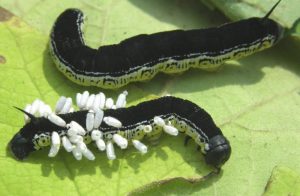
Interesting natural history tidbits sometimes come in the strangest ways. I was down at the river with one of my grandsons, Sam, who was fishing. A boat pulled out at the ramp and one of the fishermen offered to give left-over bait to Sam including some minnows and bean worms. Now I know what shiners are but had never heard of bean worms. So we accepted the bait and observed that these “worms” were actually caterpillars. Indeed they were larvae of the catalpa sphinx moth, Ceratomia catalpae . This species is known as a “barfer” since it vomits up greenish goo to r
epel attackers! But something strange was going on with the “worms,” many of them had peculiar white tubes attached to them (see photo of a normal caterpillar at top as a comparison).
Do you recognize what the meaning of th
ese white objects is?
These are in fact the cocoons of a parasitic braconid wasp that injects eggs into the caterpillars. The larvae feed inside the caterpillar and subsequently bore through the skin and spin cocoons outside attached to the skin. Note that these cocoons are in fact open at the end and obviously the wasps have emerged as adults and flown away. The caterpillars generally die fairly soon after having their insides eaten away. This can be a fairly gruesome way to imagine dying (a living death of sorts), even if you are not particularly fond of caterpillars. Similar kinds of parasites are in fact used as a means of biological control, and in fact some flies released to control exotic gypsy moths have decimated the populations of some native silkmoths.
So if you have access to a catalpa tree, watch out for this interesting form of fish bait and marvel once again at the complex and intricate web of life.
Bill Dunson, Englewood, FL & Galax, VA
wdunson@comcast.net

